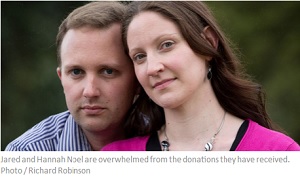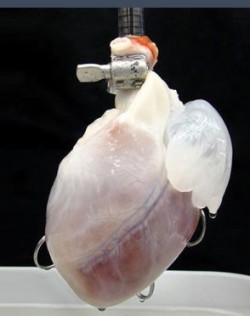 Jared Noel has just one wish before he dies following a five-year battle with cancer: to see his yet-to-be-born daughter.
Jared Noel has just one wish before he dies following a five-year battle with cancer: to see his yet-to-be-born daughter.
“My greatest hope is that I get to spend some time with her and enjoy fatherhood. She won’t know me. She won’t remember me. But I’d like to let her know how much I would have wanted to be there when she’s 18, when she’s 25,” he said.
Dr Noel, 32, a physician at Auckland City Hospital, New Zealand was diagnosed with bowel cancer in November 2008. He has since battled through 66 rounds of chemotherapy and two major operations. Despite knowing the cancer would eventually beat him, he and his wife, Hannah, decided to try for a baby in the hope that he would live long enough to experience the first part of his child’s life. After four rounds of IVF, they succeeded, and their daughter is due on January 21. But last week, the couple were given the devastating news that the cancer had grown rampantly in Dr Noel’s liver and spread to his lung.
Without more chemo, it was unlikely he would live past Christmas. “This is the moment we have been dreading for five years and have been lucky to escape until now,” Dr Noel wrote on his blog on Saturday after receiving the diagnosis. “This is where everything changes. I have a lifespan measured in months. “The disappointment is compounded by knowing we have a daughter waiting to meet us, and for the first time, doubt has been cast over whether or not I will make that meeting. This is aggressive cancer, doing its best to kill me, to rob our child of their father.”
The couple did not have the money to pay for the drug Avastin, which it’s hoped will slow the growth of the tumours enough to extend Dr Noel’s life expectancy beyond the birth of his daughter – though it will not cure him. Ten courses of the medicine, which is not funded by Pharmac, cost $60,000.
Dr Noel said he had always been “a little reluctant to pay for a drug that does not change outcome”. But in light of his imminent fatherhood, he said, his life expectancy had become more important and he was open to fundraising for the Avastin.
“If it wasn’t for her [the baby], we would do our best and let nature take its course. But all of a sudden months and weeks are the difference between meeting my daughter or not and maybe the difference between me having a few months with her or not. It means a lot to Hannah, as she’ll get to see me holding her. I’m doing it mainly for Hannah and my daughter now.”
As a result they allowed a friend to set up a page on fundraising site Givealittle appealing for the $60,000. The page went live last week and within seven hours it had raised the money. Within days the fund has reached $158,000. Many of the donations came from anonymous donors or people who did not know the Noels.
One woman has offered to give Dr. Noel her own Avastin injections, which she receives every two months. The 67-year-old, who lives in Glen Eden, Auckland is starting to lose her eyesight and while the injections are not a cure, they are helping to slow the process. “It’s fully funded and I have no idea why this young man can’t get Avastin injections for his much worse problem. But I am absolutely prepared to give up my Avastin injections. I’m losing my sight. But I don’t care about that. This boy needs to be given some time. It’s just sensible. I’m 67 years old, why do I need them? This is a young boy with a family coming.
A Givealittle spokeswoman said it was the quickest a fundraising target had been reached since the site was set up in December 2008.
Dr Noel said he was overwhelmed by the generosity shown. “I have no words. We’re just stunned. We’re grateful and humbled by it all. It’s just so overwhelming. I knew there was some support and empathy out there but the response that we’ve got – I have no words.” He said the extra money raised would go towards giving his wife financial security after he is gone. However, if it continued to come in at the present rate, he would consider setting up a trust to benefit his daughter.
Dr Noel said he planned to have his first course of Avastin and restart chemotherapy next week. He vowed to give his all to make sure he was there for the birth of his daughter.
“I’m at the business end of the fight now. But I’ve outlived everybody’s expectations so far. I can make it.”






